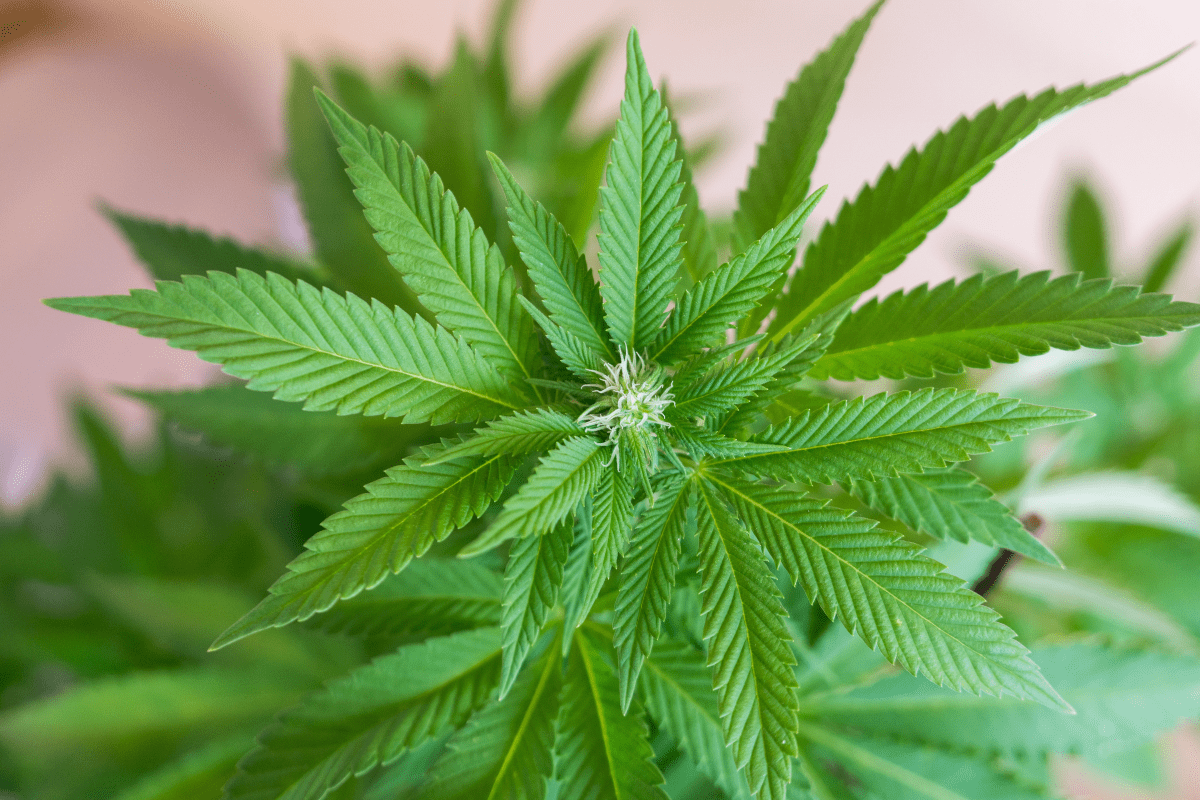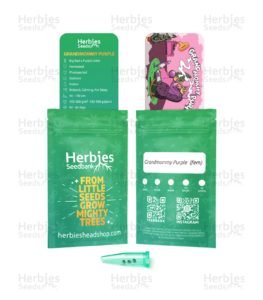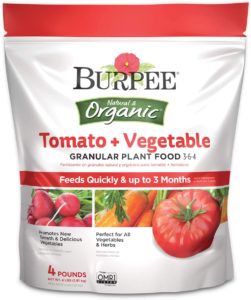During the flowering phase, cannabis plants need special nutrients. It can be hard to find the exact right time to switch to flowering nutrients.
Most plants need you to switch to flowering nutrients three weeks into the flowering stage. Be sure to check your feeding schedule as well as the strain you are growing.
That said, there’s a lot more to know. There are differences between indoor and outdoor cannabis plants, as well as autoflower vs photoperiod plants. We’re providing an overview of bloom nutrients. By the end of this, you’ll have a comprehensive guide to everything that goes into the switch to flowering nutrients.
What is the Flowering Stage?
Cannabis plants naturally grow in three main stages: seedling, vegetation, and flowering. In the seedling phase, your cannabis plant needs minimal nutrients. It’s in the vegetative stage and flowering stage that nutrients are critical.
During the vegetative stage, the cannabis plant is growing a lot. Vegetative growth includes the stalks, branches, and roots that it needs to be able to support big buds. Veg fertilizer contains a lot of nitrogen to support the vegetative growth of the plant.
Once cannabis enters the flowering phase, it finally starts to grow smokable buds. Flowering plants need more phosphorus and potassium than nitrogen.
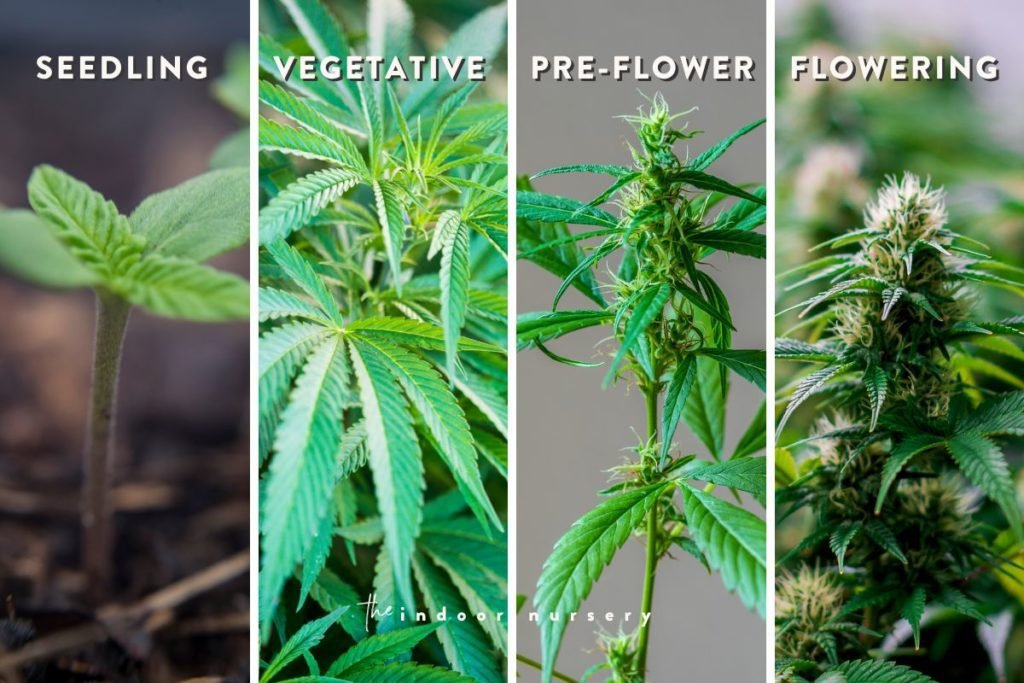
4 Parts of the Flowering Stage
The flowering stage lasts 7-9 weeks for most strains. It can be broken down into four parts: early bloom, mid bloom, late bloom, and flush. It needs different ratios of NPK at different times.
Early bloom: in the first 2-3 weeks of flowering, cannabis still has some vegetative growth to do. It will undergo what is called “flowering stretch,” where it can double in height. At this point, they will need a fertilizer with an NPK ratio that has a bit less nitrogen and a bit more phosphorus and potassium.
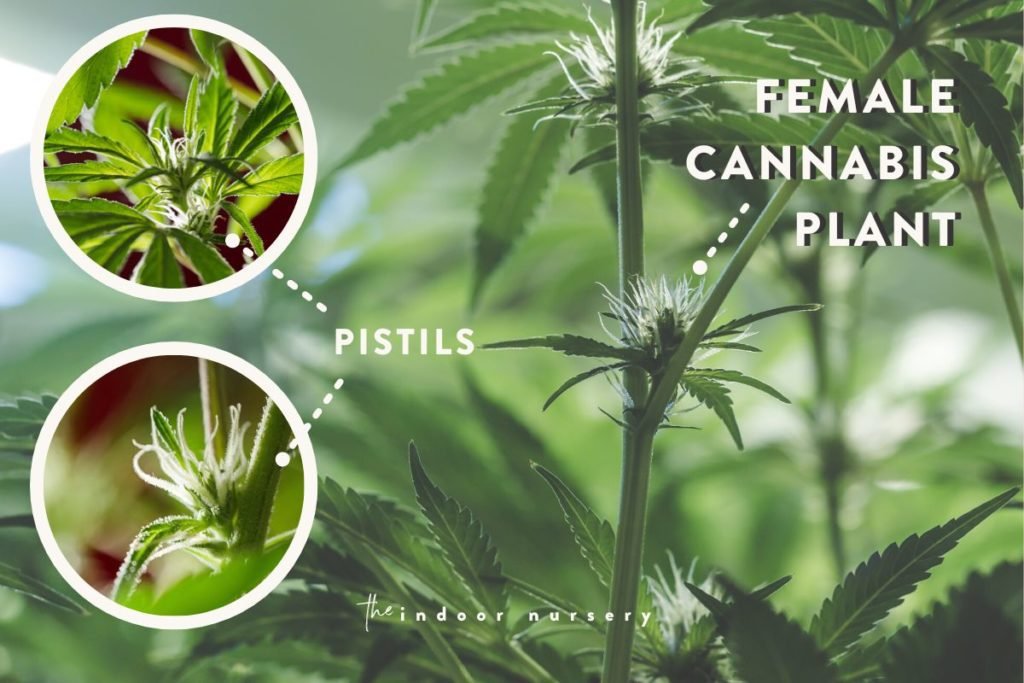
You might think that it’s still in veg because it’s getting so much taller. It’s best to switch to flowering nutrients here. You want your plants to have a backup of nutrients to build flowers. We like to use something around 5-7-10.
This is also the phase where you sex your plants if they are not clones or grown from feminized seeds. If your plants are female, they will grow little white hairs in their calices. If they are male, you’ll get pollen sacs.
Mid Bloom: at week 4-5 of the flowering phase your plant will stop growing taller. This is when the plants start getting more and more white pistils, with some turning yellow. This is when you go into full bloom nutrients. At this point, you will fully make the switch to flowering nutrients. We like using a bloom fertilizers NPK ratio of about 6-10-15.
Late Bloom: this is weeks 6-9 in the flowering process. By now the hairs should mainly be turning yellow or orange. At this point in the flowering process you want to be tapering off the nutrients. Around here we go down to 4-7-10.
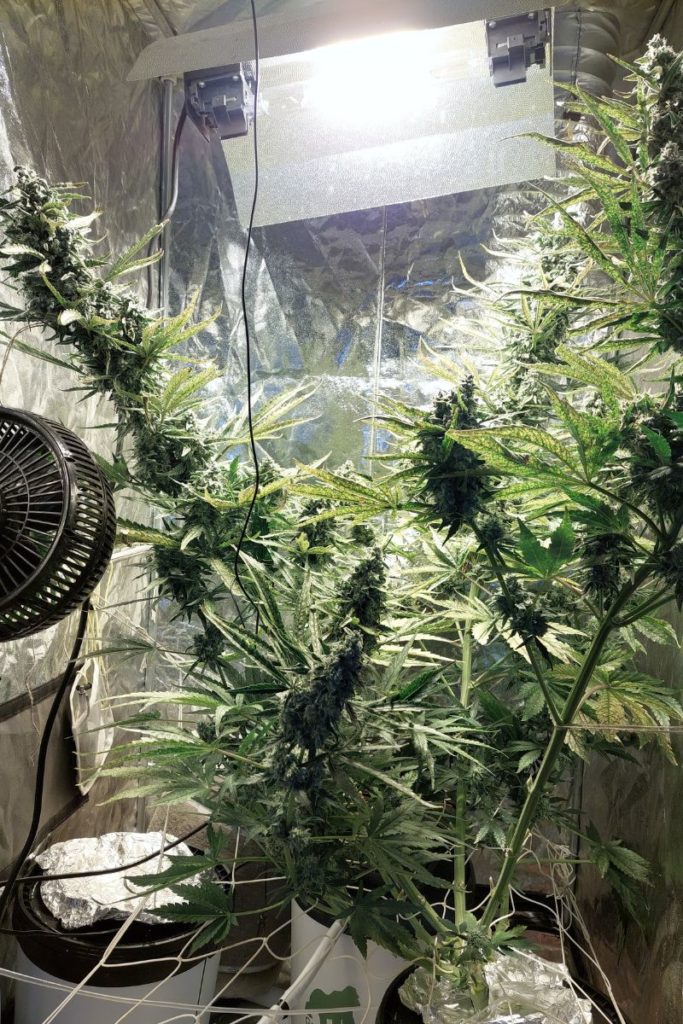
Flush: This is the last 1 or 2 weeks before harvest. You want to give it no nutrients. If you’re growing these plants in dirt, flush them for at least 2 weeks. If you’re using hydroponics, 1 week should be fine. If you don’t flush, your buds will taste funky.
When Do Cannabis Plants Enter the Flowering Stage?
In the wild, cannabis plants are photoperiodic plants. This means that cannabis enters different phases of its growth depending on how much light per day it’s getting.
Photoperiod cannabis enters the vegetative stage when it gets more than 12 hours of light per day. It begins the flowering stage when it gets less than 12 hours of light per day.
Mind you, this is specifically for photoperiod cannabis. Many growers like to use autoflower cannabis, especially for outdoor plants. Autoflower cannabis is crossbred with hemp. It enters the flowering cycle due to its genetic programming, regardless of how much light it gets. Most autoflower cannabis will begin flowering after 5 weeks of growth.
Autoflower typically has a quicker and more predictable flowering cycle. It also has smaller yields than regular cannabis. The buds are not quite as potent due to its crossbreeding with cannabis ruderalis.
However, most growers who do indoor growing opt for photoperiod cannabis. The reason for this is that you can shorten the vegetative phase and trigger flowering just by turning your lights off.
Tips For Shortening the Vegetative Phase of Indoor Plants
Be sure to give your plant at least 2-3 weeks to veg. It needs some vegetative growth to support the buds. It’s both a point of pride and panic when your cannabis begins to collapse under its own weight in the middle of the flowering cycle.
What Kind of Flowering Fertilizer Do I Need?
Bloom fertilizer has an NPK ratio that is heavier on phosphorus and potassium to support bud growth. You may also choose to add a “bloom booster” at this point if you haven’t added any other supplements.
If for whatever reason you cannot purchase cannabis nutrients, you can also use fertilizers made for tomatoes or roses. Do not use lawn fertilizer. Lawn fertilizer like Miracle-Gro contains long-release nitrogen which isn’t good for flowering cannabis. Rose and tomato fertilizers are made for flowering plants, so it contains the right nutrients for your cannabis.
Organic vs Synthetic Bloom Nutrients
Which type of bloom fertilizer reigns supreme? Organic or chemical fertilizers? They both have advantages.
Organic nutrients have a slower uptake and are better for people who are prone to overfeeding. They’re also better for the ecology of your garden if you’re concerned about that. Many growers insist that it tastes better. You will not need to flush organic nutrients as long.
Chemical fertilizers are stronger. If you’re dealing with a nutrient deficiency that’s gone on for too long. That said, these are way more likely to cause nutrient burn or even nutrient lockout. Make sure to use them sparingly.
When Should I Switch To Flowering Nutrients?
Pretty much all cannabis fertilizers come with a feeding schedule that will tell you when to switch to flowering nutrients. Look up the feeding schedule as well as your strain’s bloom phase.
That said, you should switch to flowering nutrients when your plant gets less than 12 hours of light or your autoflower plant gets to about 7-10 weeks. If you start to notice white hairs at the calyces, switch to flowering nutrients immediately because you’re already about 3 weeks into the flowering phase.
Common Flowering Nutrient Issues
The flowering phase is a critical time for your plant. You don’t want things going wrong while you’re in the home stretch. Here are some common issues to look out for.
Nutrient Burn
Nutrient burn, or fertilizer burn, occurs when plants get too many nutrients. They cannot excrete excess chemicals like animals can. Instead, they push all the nutrients as far away from the center as it can, which is the tips of the leaves.
When your plant is undergoing nutrient burn, your leaves will have an oversaturated green hue and look burned at the end. Nutrient deficiencies can also have a similar appearance but treat burn first if you think it’s burn.
Avoid nutrient burn by sticking to your feeding schedule and not going over. Also only use one or two supplements, those are easy to overload.
Nutrient Lockout
This is when your plant just straight up cannot take in anything. It will completely stop the plant from growing. Nutrient lockout can happen for two reasons:
- The pH of your soil will not allow your plant to take in nutrients
- The dirt is oversaturated in fertilizer salts
This is why it’s very important to always pH test your dirt or hydroponic water. A common saying among growers is “cannabis teaches you that you can give too much.”
Nutrient Deficiencies
Nutrient deficiencies can also limit how much your plants grow. Certain nutrient deficiencies are worse than others. You can diagnose them by looking at the leaves. Unfortunately, much like medical diagnoses, there are many deficiencies that have the same symptoms.
If you have leaves that could be either deficient or burned, treat the burn first. If treatment for burn makes it worse, chemical fertilizers can easily bring it back to life. It’s harder to take out nutrients when you pushed it from burn to lockout.
FAQ
When will my outdoor plants reach the flowering stage?
Photoperiod cannabis will start flowering after the summer solstice. Autoflower will start flowering at about 10 weeks.
Can I start flowering my plants early?
Most indoor growers opt to shorten the vegetative growth phase. All you need to do is switch your lights to be on for less than 12 hours a day.
How long does the flowering phase last?
Most cannabis strains take about 7-9 weeks to complete the flowering stage.
Should I use bloom boosters?
If you haven’t added any other supplements, go ahead and use a bloom booster during the flowering phase. Be careful with supplements though, it’s easy to use too many.
More about cannabis
- How To Treat A Magnesium Deficiency In Cannabis
- It’s Not O-K: Potassium Deficiency in Cannabis
- How to harvest cannabis (and use the entire plant)
- Male Weed Plant Stages: Don’t Ruin Your Crop
- How To Decarb Weed For Homemade Cannabis Products
- Loving the Ladies: Female Weed Plant Stages
- Patience is a Virtue: Curing Buds for Best Taste
- Understanding weed light cycles: Get the most from your harvest
- When to switch to flower nutrients for high cannabis yield
- How to make live resin at home, step-by-step

